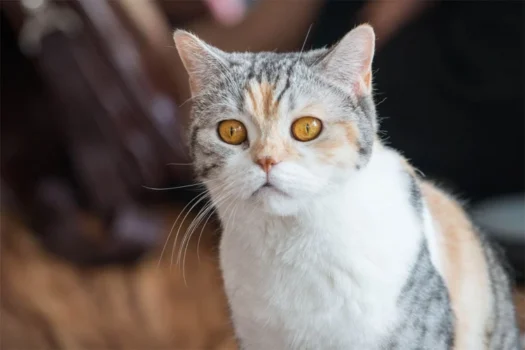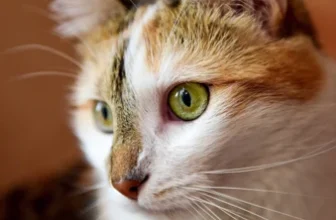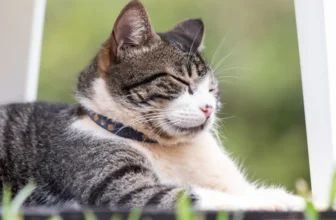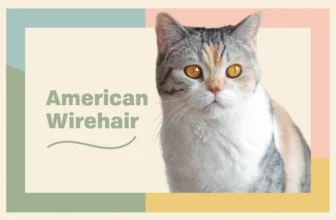The American Wirehair is a breed of cat known for its unique and distinctive fur. Unlike other cat breeds, the American Wirehair has curly or wiry fur. What makes this breed’s fur so unique? And what are the genetics behind it? In this article, we’ll take a closer look at the genetics behind the American Wirehair’s curly fur, explore the dominant gene responsible for it, and understand how breeding can affect its expression. Let’s dive into the fascinating world of cat genetics and discover the secrets behind the American Wirehair’s peculiar fur.
The American Wirehair’s Unique Fur
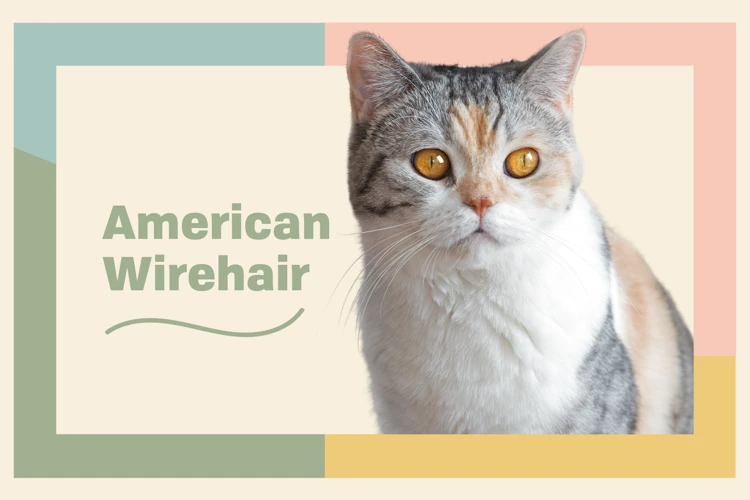
The American Wirehair is a distinct and eye-catching breed, known for its unique fur. This breed stands out from other cats due to its peculiar fur which comes with a range of different textures and colors, varying from coarse to soft and curly or wiry in appearance. It is always interesting to learn about its characteristics, genetics, and grooming procedures. If you want to delve deeper into understanding the American Wirehair’s fur, keep reading this article! You can also learn more about American Wirehair coats, color variations, grooming, and how they compare to other wirehair cats by clicking on the appropriate links.
What Makes American Wirehair’s Fur Different from Other Breeds?
The American Wirehair is a unique breed that stands out among other breeds for many reasons, and their fur is no exception. What sets them apart from all other breeds is that they have a thick and wiry coat that appears crimped or curled. This texture makes them stand out among other cats as their fur is both unique and eye-catching.
Their coat is resilient: One of the most notable characteristics of the American Wirehair’s fur is how resilient it is. It is resistant to both water and dirt, which makes it easy for owners to groom and care for them.
Their fur is hypoallergenic: For those who have allergies to cats, the American Wirehair is a great choice as their fur is hypoallergenic. This means that they produce less allergens than other cat breeds, which is great news for those who love cats but experience allergic reactions.
Color variations: Despite their unique fur, the American Wirehair comes in a variety of colors and patterns. They can be solid colors such as white, black, or brown, or they can have patterns such as tabby or tortoiseshell.
Not all wirehairs are the same: While it may be tempting to group all wiry-haired cats together, the texture of the American Wirehair’s fur is unique to their breed. Other breeds of wirehaired cats, such as the German Wirehaired Pointer, have fur that is straighter and coarser.
The American Wirehair’s fur is a defining characteristic of the breed. Its texture, color variations, and hypoallergenic qualities make it a wonderful choice for cat lovers looking for a unique and low-maintenance pet. For more information on the American Wirehair’s coat, be sure to check out our article on American Wirehair Coats.
Curly or Wiry? Understanding the Texture of the American Wirehair’s Fur
The texture of the American Wirehair’s fur is unique and often described as “curly” or “wiry.” It is essential to understand the difference between these two textures to identify the American Wirehair breed. While both textures have a springy appearance, there are some differences in their appearance and feel.
Curly Fur: The curls of the American Wirehair’s fur are more prominent, tighter, and have a more defined shape. The fur is also generally softer to the touch. Individuals with curly fur often have a distinctly different appearance compared to those with wiry fur. This difference in appearance is due to genetic variation. Some cats may have a mix of both curly and wiry fur textures, leading to a unique appearance.
Wiry Fur: The wiry texture of the American Wirehair’s fur is less defined than curly fur and has a more rough feel to it. It is often coarser and less dense than curly fur. Although wiry fur is not as common as curly fur, it does appear in some American Wirehairs.
It is important to note that the texture of American Wirehair’s fur can vary from cat to cat and can also change over time. Some cats may have a more defined curly texture when they are kittens but develop a wiry texture as they age. Proper grooming can help maintain the texture of a cat’s fur.
The texture of an American Wirehair’s fur is a defining characteristic of the breed. Understanding this characteristic is essential for identifying an American Wirehair and appreciating the beauty of their unique coat. For more information on the variety of coat colors that American Wirehair cats can have, see our article on American Wirehair Cat Color Variations. Proper grooming techniques can help maintain the appearance and texture of an American Wirehair’s fur – learn more in our article AmWirehair Grooming. Additionally, it is interesting to compare and contrast the American Wirehair to other wirehair breeds. See our article on American Wirehair vs Other Wirehair Cats to learn more.
Genetics Behind American Wirehair’s Curly Fur
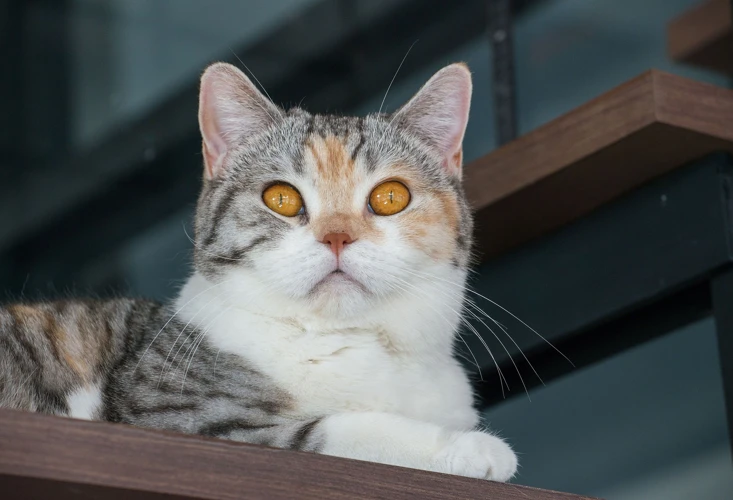
The American Wirehair’s unique fur has been a topic of fascination for many years. This curly coated cat breed is unlike any other, but what is the reason behind their one-of-a-kind fur? Curiosity led scientists to examine the American Wirehair’s genetics, in hopes of unraveling the mystery behind their signature feature. So, let’s dig deeper into the fascinating genetics behind the American Wirehair’s curly fur and discover how this breed’s coat differs from others. But before that, let’s explore the various color variations these amazing cats have to offer.
What is a Dominant Gene?
Genes play a vital role in determining the traits of an organism, including physical characteristics like hair color and texture. A dominant gene is a gene that can express its characteristic when present in just one of two homologous chromosomes, overriding the other allele. This means that the dominant allele will always be expressed, even if it only appears in one parent.
Examples of dominant genes include:
- Brown eyes over blue eyes
- Straight hair over curly
- Attached earlobes over free earlobes
It is important to note that just because a trait is dominant, it does not necessarily mean that it is the most common trait in a population. For example, while brown eyes are a dominant trait, blue eyes are much more prevalent in certain populations.
Dominant genes can have a significant impact on the physical characteristics of an organism, as evidenced by the American Wirehair’s unique curly fur. Understanding the dominant gene responsible for this trait is key to understanding how it is passed down from one generation to the next.
Identifying the Gene Responsible for the American Wirehair’s Unique Coat
The unique coat of the American Wirehair is not just a result of a random mutation, but rather, a specific gene that has been identified by researchers. This gene, known as the Wh gene, is responsible for the wirehair coat texture of the American Wirehair breed. This dominant gene is what makes the fur of American Wirehairs stand out from other breeds.
Researchers have studied the DNA of American Wirehairs and found that this Wh gene is responsible for the wirehair texture, and that this gene is passed down from one generation to the next through simple Mendelian inheritance. In other words, if a cat inherits this gene from just one parent, it will express the wirehair coat texture.
Interestingly, this gene does not just affect the fur of American Wirehairs, but it can also affect other parts of the body such as the eyebrows, whiskers, and even the shape of the ears. However, it is important to note that this gene does not necessarily lead to the development of other wirehair features. For example, an American Wirehair that has inherited this gene from only one parent may not possess these other wirehair attributes.
The identification of the Wh gene has been a significant breakthrough in understanding the genetics behind the American Wirehair’s unique fur. It has shed light on how dominant genes can affect the physical characteristics of animals, and how they can be passed down from one generation to the next. With this knowledge, breeders can now selectively breed cats to enhance the wirehair traits, ultimately improving the overall quality of the breed.
How Breeding Affects the Expression of the Dominant Gene.
Breeding plays a crucial role in the expression of the dominant gene responsible for the American Wirehair’s unique fur. Here are some of the ways breeding affects the expression of the dominant gene:
- Selective Breeding: Selective breeding is the process of choosing particular cats with desirable traits and breeding them together to produce offspring with those traits. Breeders can selectively breed American Wirehairs to strengthen the dominant gene responsible for the curly fur.
- Crossbreeding: Crossbreeding is the process of breeding two different breeds to create a new breed. When an American Wirehair is crossed with a different breed, there is a chance that the dominant gene for curly fur can be diluted or lost in the offspring. Breeders must take care to select cats that carry the dominant gene to preserve the unique fur trait.
- Linebreeding: Linebreeding is the process of breeding closely related cats to maintain a particular trait or characteristic. Breeders can use linebreeding to strengthen and intensify the dominant gene for curly fur in American Wirehairs.
- Outcrossing: Outcrossing is the process of breeding two unrelated cats from the same breed to introduce new genes and prevent inbreeding. However, outcrossing can also dilute the dominant gene for curly fur in American Wirehairs, so breeders must select cats carefully to maintain the unique fur trait.
Breeding can have a significant impact on the expression of the dominant gene for curly fur in American Wirehairs. By selecting the right cats and breeding carefully, breeders can maintain and strengthen this unique trait in the breed.
The Complexity of Coat Genetics
Understanding the genetics behind a cat’s coat can be quite complex. For example, the American Wirehair’s unique fur is the result of a dominant gene which can be passed down through breeding. However, it’s important to note that genetics is not always a black and white matter. In fact, there are many factors that can influence the expression of specific traits.
One of the most significant factors is environmental influences. For example, exposure to sunlight can cause a cat’s fur to change color or even lighten. Additionally, diet and grooming practices can also impact the fur’s texture and overall appearance.
Another element that plays a role in coat genetics is something called “polygenic traits.” These are traits that involve multiple genes and can be influenced by a variety of factors. For example, a cat’s hair length is influenced by multiple genes, making it a polygenic trait. This is why some cats may have longer hair than others, even within the same breed.
Coat genetics is not limited to just the hair on a cat’s body. It also includes traits such as eye color and pattern. In fact, the genetics behind coat patterns such as tabby, tortoiseshell, and calico can be quite complex and involve multiple genes.
Understanding the complexity of coat genetics can be quite perplexing, even for experts in the field. Environmental factors, polygenic traits, and a variety of genes all play a role in determining a cat’s coat characteristics. While we may never fully comprehend the intricacies of coat genetics, we can appreciate the beauty and uniqueness of each individual cat’s coat.
Conclusion
After delving into the genetics behind the unique fur of the American Wirehair, it becomes clear that there is much more to a cat’s coat than meets the eye. The curly/wiry texture of the American Wirehair’s fur is determined by a dominant gene, which can be passed on through breeding. However, the complexity of coat genetics means that it is not always straightforward to predict the fur type of a litter of kittens.
Despite this complexity, many breeders and enthusiasts are drawn to the American Wirehair for its striking appearance and playful personality. It is important for potential owners to understand the unique needs of this breed, including regular grooming to prevent matting and possible dermatological issues.
As our understanding of feline genetics continues to grow, it is fascinating to contemplate the multitude of traits that are determined by our cats’ genes. From coat textures to eye colors and beyond, these genetic variations make each cat truly unique and special. As we continue to breed and care for our feline companions, we must strive to prioritize their health and well-being above all else.
Frequently Asked Questions
What is the American Wirehair’s Unique Fur?
The American Wirehair has fur that is dense, curly, and thick with a unique texture and appearance compared to other breeds.
What Causes the American Wirehair’s Fur to be Unique?
The American Wirehair’s fur is the result of a dominant gene mutation that affects the texture of their coat, resulting in a wiry, curly appearance that is distinct from other breeds of cats.
What is the Difference Between Wiry and Curly Fur?
Wiry fur is characterized by stiff, coarse hairs that are often thick and curly. In contrast, curly fur is made up of soft, spiral-shaped hairs that form tight curls that are often small in size.
Why is the American Wirehair’s Fur Important to Study?
The American Wirehair’s unique fur genetics provide insights into the complex genetic mechanisms behind coat texture and allow us to better understand how mutations can impact physical characteristics in different species.
Can Other Cat Breeds Have Wiry Coats?
Yes, other cat breeds can have wiry coats as well. However, the wiry texture of American Wirehair cats is unique and distinguishable from other breeds.
A dominant gene is one that is always expressed in an individual’s phenotype, regardless of whether they inherit another gene that might be different.
What Happens When Two American Wirehair Cats Mate?
When two American Wirehair cats mate, their offspring have a high likelihood of inheriting the dominant gene mutation, resulting in a curly, wiry coat similar to their parents.
What is Crossbreeding, and How Does it Affect Coat Genetics?
Crossbreeding involves mating two different breeds of cats. Depending on the genetic makeup of the parents, crossbreeding can result in offspring with a range of coat textures and appearances.
How Might Understanding Coat Genetics Benefit Cat Breeding?
Understanding coat genetics can inform cat breeding practices and help breeders selectively mate cats with the desired coat characteristics, resulting in cats with more predictable and desirable physical traits.
What Can We Learn About Genetics from Studying Animal Coats?
Studying animal coats provides insights into the underlying genetic mechanisms that govern physical characteristics in different species. By understanding how genes affect traits such as coat texture, we can gain a better understanding of how genetic diversity and variation arise in different populations.

